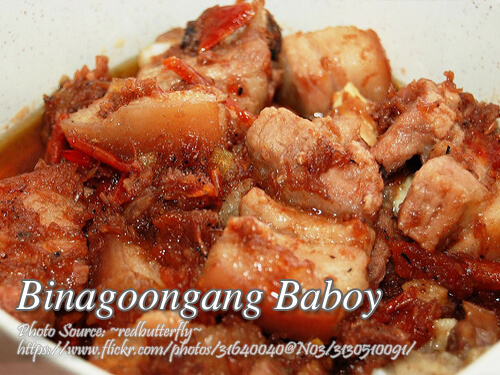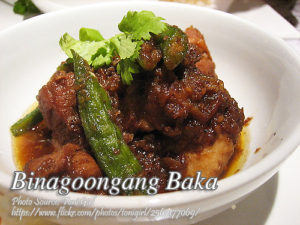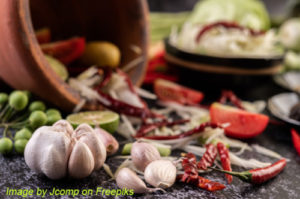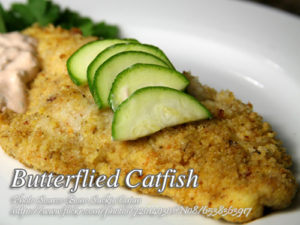Binagoongang baboy is an authentic Filipino dish. The basic cooking process of this dish is cooking slices of pork with the bagoong (shrimp paste) and adding spices. Shrimp paste or bagoong is readily available in the local wet market and since it is still fresh, the usual color is pink and watery. Those shrimp paste you see in the supermarket are already processed and sauteed with spices and sometime sugar is added. The color is usually brown and they are already cooked to prolong the shelf life.
Whether fresh bagoong or those bottled ones sold in the supermarket you prefer to use on your recipe, it will depend on your taste and availability. But personally I prefer the fresh bagoong. Just make sure it is fresh because some vendors in the wet market sells stinky bagoong which is already fermenting. Fresh bagoong shouldn’t be so repulsive and stinky and not very salty. Binagoongang baboy is a perfect combination with grilled or boiled eggplant or okra. It can also be a perfect side dish with grilled bangus or grilled tilapia.
Binagoongang Baboy: A Taste of Tradition and Home
I was toast already when I first caught whiffs of the sizzle of binagoongang baboy in my lolo’s kitchen. The smell of pork slow-cooking in rich, savory shrimp paste; unmistakable to the heart with a room full of comfort. It became a staple in our family gatherings, just like in many Filipino households, where it is paired with fresh vegetables, grilled eggplant or okra, and can even be served with grilled fish, such as tilapia or bangus. It’s not just food; it’s a memory that connects us to our roots and traditions.
A Dish Steeped in Filipino Heritage
At its core, binagoongang baboy is the very epitome of Filipino cooking: bold, savory, and full of flavor. It’s what makes this dish somewhat different from others-the bagoong, or shrimp paste, which is a staple in every Filipino’s kitchen. Whether fresh and pinkish from the wet market or bottled and sautéed from the supermarket, bagoong has become the emblem of salty, umami-packed flavors that we Filipinos just adore.
In my family, fresh bagoong was always preferred, if available. My uncle was one of those who loved the wet market every Sunday, so we made sure that only the best ones passed our standards. He often warned us not to bring home the smelliest bagoong ; he believed that the perfect bagoong should have just a hint of that salty scent, a whiff enough to perk one’s senses without being too overpowering. Of course, those supermarket versions are handy and already sautéed to make them last longer, but nothing is as authentic as the fresh shrimp paste, especially when it is included in this wonderful dish.
Grandmother’s Secret Tips For Binagoongang Baboy
Preparing the binagoongang baboy does not seem like such a feat for a first-timer, what with the strong flavour profile of bagoong. But really, it’s very simple. As my aunt taught me how to cook, I was reminded that cooking requires balancing flavors; there’s such a thing as too much bagoong, which makes it too salty; too little, and you’re missing that rich flavor.
Start by boiling the pork in a mixture of garlic, vinegar, and water. It does not just tenderize the meat but also gives it flavor before you put in the shrimp paste. When the pork has softened, it’s all about getting the garlic and onion to a really fragrant sauté, including the bagoong, then letting it cook for a few minutes to help mellow out the sharpness of that shrimp paste so that it could really blend in well with the rest of the ingredients.
And finally, adding the broth back in the pan ensures it is rich and saucy with peppercorns producing a mellow heat kindlier to savory notes. A simple process makes it unforgettable because of the depth of flavor in the dish.
Bagoong: Not Just for Pork
Bagoong may be prepared as a staple for many pork dishes. While this binagoongang baboy is perhaps the most common way Filipinos appreciate bagoong, it is far from the only way. In fact, bagoong has a history in the Philippines that stretches centuries back, when seafood was used for preservation. Its use over time has extended to other dishes-well, kare-kare and pinakbet among them-that make bagoong a staple part of Philippine cuisine.
My family experimented with bagoong in different ways. When my sister who, for several years, lived in the northern provinces, decided to concoct a version using beef instead of pork, I was sceptical. It was certainly different, but that shrimp paste still worked beautifully with the fattiness of the meat. And another time we added chunks of green mango for a tangy contrast to the salty sweetness of shrimp paste. That became another winner in one of our family reunions.
Pairing and Serving Suggestions
One of the beautiful things about binagoongang baboy is that it is best with simple side dishes. My grandmother used to serve it with freshly grilled eggplant; the smokiness provides a good balance against the boldness of the dish. Other times, she’d boil okra or steam string beans for their natural sweetness to have a balance against the salty flavor of the pork.
Another family favorite was on how to serve it-grilled bangus or tilapia. The fish would be placed right beside the pork on the plate so each bite could be a mix of flavors and textures-the crispy skin of the fish, the tender meat of the pork, and that unmistakable taste of bagoong. Really, it is a meal that brings me back to childhood, when we dined with cousins from a big endless table spread with food.
A Food and Cuisine that Unites People
Whether you are using fresh bagoong bought from the wet market or a bottle version from the supermarket, this dish has a way of bringing people together. It’s the true comfort food, reminding one of his or her home and family. And with each mouthful, memories come flooding back – afternoons spent in my grandmother’s kitchen, wrapped in the smell of garlic and shrimp paste, and brotherly sibling sisters’ laughter as we waited for our meal.
Bagoong is another ingredient that scares off many beginners in Filipino cooking. Of course, its intense flavor can overwhelm if not gotten used to first. So, do not be discouraged and help yourself to this great pork recipe that will initiate you into the richness that our food has. Once you experience how good it tastes, I am confident that it will find its way to your family’s table just like it has to mine. Want to try the chicken version? Check this binagoongang manok recipe!
How to Cook Binagoongang Baboy
Ingredients
- 1 kilo pork (pork belly, pork shoulder or pork butt) cubed
- 8 cloves garlic crushed
- 1/2 cup vinegar
- 1 1/2 cups water
- 4 cloves garlic crushed
- 1 pc small onion chopped
- 2 tablespoons bagoong shrimp paste
- 1 teaspoon peppercorns
Instructions
How to make binagoongang baboy:
- In a pan put together pork, garlic, vinegar and water. Simmer for 30 minutes.
- Drain pork and reserve broth. Sauté garlic and onion.
- Add bagoong and cook for 5 minutes.
- Add pork, broth and peppercorns. Simmer till pork is tender. 6 portions.
Notes
Cooking Tips:
Use fresh bagoong for better flavor
Fresh bagoong from the wet market, if possible, is best because it offers a brighter, balanced flavor instead of the processed ones. The subtle brininess from the fresh shrimp paste would actually complement the flavor of pork without the latter becoming too salty. Check if it smells clean or briny and not too pungent or fermented.Simmer the Pork to Tender Perfection
Slow-cooking pork in the pan with vinegar, garlic, and water will ensure that the meat turns out really tender and juicy. Simmering over such a long time will not only soften the meat but also give a slightly neutralized flavor from the gamey taste of the pork. Let it simmer low and slow for at least 30 minutes so the flavors get soaked up nicely into the pork, making it really fall-off-the-bone tender.Balance the Saltiness with Vegetables or Citrus
Since bagoong is salty, it can be paired with grilled vegetables like eggplant or a squeeze of calamansi to balance out the flavor. The smoke sweetness coming from the vegetables or the citrus tang from the calamansi is just such a refreshing contrast to the richness of the pork. That makes for a feel that is lighter and more harmonious on the palate.






this recipe is the best for me,love it!
Hi Leviata, I’m sure you are going to love this recipe!
Thank you for sharing this recipe. I was searching for a recipe that matches whatever available ingredients I have at the moment. A great thing I came across your article. I know where to look for next time. Kudos! 🙂
Hi Rowana, I’m happy that the binagoongang baboy recipe has helped you cook the dish without going back again to the market. Cheers!
Thanks for the tips about choosing the kind of shrimp paste. I thought bagoong is usually stinky so most foreigners don’t like the smell of it. So the next time I buy I will make sure it is fresh.
Super dish!!! Very easy and the flavor is fantastic. This recipe will be in my files and will be used forever.
Thanks for sharing.
This sounds good im trying it tonight..